





 |
 |
 |
 |
 |
 |
| Dave Thomas | profile | all galleries >> Thru a Pinhole >> X-ray Film Tests | tree view | thumbnails | slideshow |
Especially in 8x10 format, the big name photographic films are a hefty investment for trifling with a few pinhole shots; partly a matter of per sheet cost but also the minimum package sizes, frequently 50 or 100 sheets. So Ye Olde Photographer has been quite interested in results obtained by people using x-ray film which often is available at remarkably low prices.
The first interesting tidbit is that X-ray films are not totally exposed by X-rays! The film holders have a phosphor layer inside that emits visible light in response to excitation by X-rays. Typical films are available as blue sensitive or green sensitive to work with corresponding phosphors.
YOP was able to purchase a 100-sheet package of Fujifilm Super HR-T in 8x10 inch (20x25 cm) size at a price less than $0.50 a sheet. Folks who have tried it report ISO values on the order of 200. There is a tendency toward high contrast which points toward using a dilute film developer, as opposed to paper developers. Unlike conventional panchromatic film, this x-ray material is green sensitive and can be handled under a red safelight.
OK - that covers the good news! The less good news: the emulsion tends to be very soft and easily scratched in handling, worse yet, on most of the common films, there is emulsion on both sides! This makes handling during processing a bit tedious. This also means chemistry consumption is twice what one might expect - developing one sheet of 8x10 x-ray film consumes as much capacity as two 36 exposure rolls of 35mm (or two rolls of 120).
After a long time getting around to it, YOP finally made a first try the week after Christmas in 2013. He cut one sheet into four pieces of 4x5. First note here - 4x5 film is actually standardized at about 3.93 x 4.93 if you are going to use regular 4x5 filmholders. A sheet was exposed in 1/3 frame sections in the 4x5 pinhole camera at ISO 100, 200 and 400 based on an incident reading. The second shot was based on the first, but we were so close to sunset the light was rapidly fading which resulted in a weak exposure. At least it appears ISO 200 is in the ballpark. And at least the ice has been broken!
The first shots were tray developed with constant agitation in HC110 1+49 for about 5.5 minutes at 67ºF.
In April 2014 as WPPD drew near, we got more serious about some testing. In forum discussions YOP has seen people claiming to use an EI ranging from 25 to 400 and all sorts of developers. There is some consensus that a film developer is preferred to a print developer to reduce unduly high contrast. We managed a few shots based on an EI of 50 and 100, although a further complication here is the film, being green sensitive, can be sensitive to time of day, as early morning or late evening tends toward reddish light which the film doesn't see.
In the most recent tests, the film was developed in 8x10 Cesco smooth bottom trays. This makes the film a bit difficult to lift out, but seems to avoid scratching the known to be soft emulsion. Pointing toward lower contrast, we tried using HC-110 at 1+63 ("Dilution H") which further reduces developer consumption.
As a remaining step we tried actual contact printing some of these, as that might not correlate 100% with inverting a scan. Since YOP's scanner doesn't go beyond 4 inch width, the negatives were digitized by photographing them on a light box with his EOS 40D. Some contact prints on Ilford MGIV came out pretty well. Using the Omega B8 enlarger as a light source, we did wind up using a #1 contrast filter. Undoubtedly there is still room for further experimentation, perhaps reducing development time could cut contrast a bit.
 HR-T Test #01 |
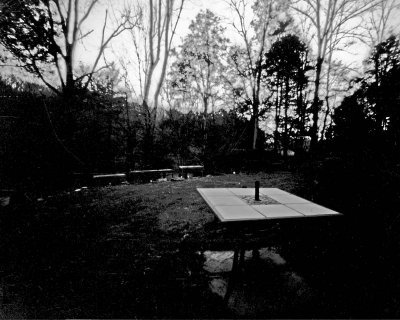 HR-T Test #02 |
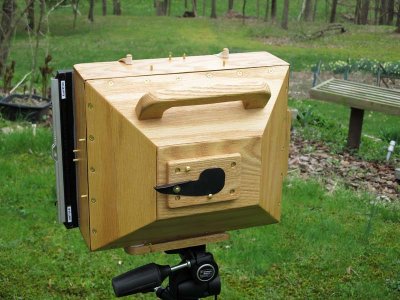 8x10 tests |
 EI 50 |
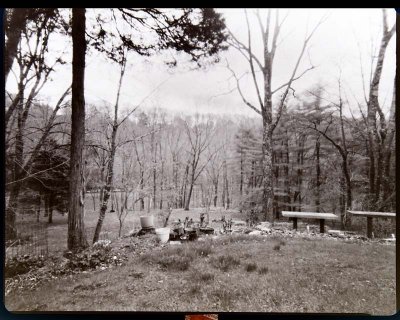 Inverted |
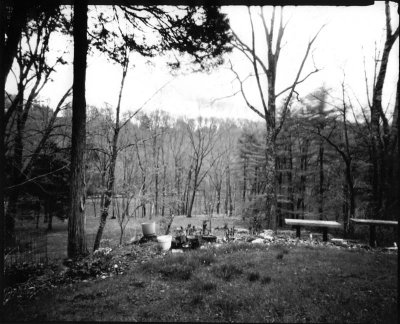 Contact Print |
 EI 100 |
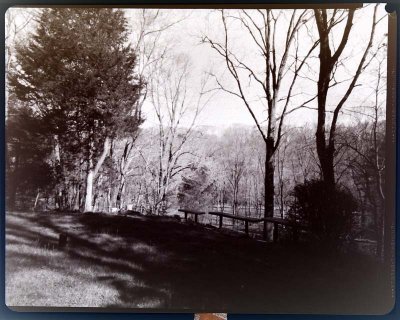 Inverted |
 Contact print |
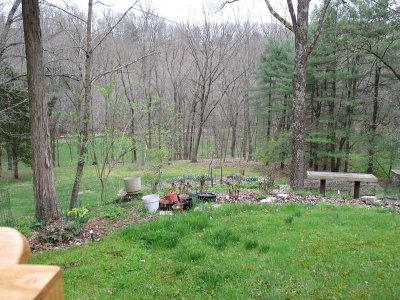 A Test Scene |